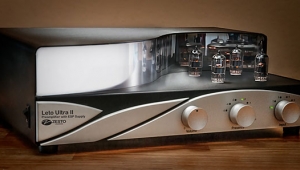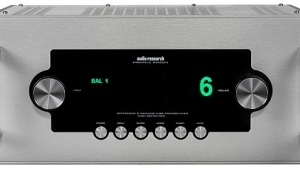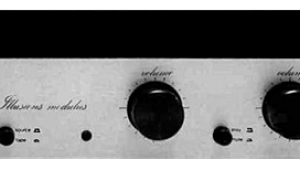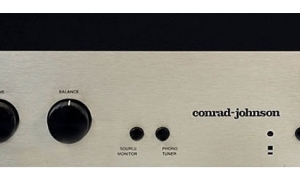| Columns Retired Columns & Blogs |
Sonic Frontiers Line 2 line preamplifier Line 3 Preamplifier, July 2000
Kalman Rubinson wrote about the Sonic Frontiers Line 3 in July 2000 (Vol.23 No.7):
When I reviewed Sonic Frontiers' $3299 Line 2 preamplifier (December 1997, Vol.20 No.12), I was completely won over by it and was somewhat disappointed when, in response to my pleading for its return, I got a spanking new Line 3 instead! I wasn't asking for more, and, at the time, didn't think I wanted more. [However], the $4999 Line 3 has not been given a full review in these pages.
Cosmetically and operationally, all of Sonic Frontiers' Line-series preamps are identical, including that great remote control, and my review of the Line 2 and MK's review of the Line 1 (Vol.20 No.11) cover that story. The SF Line preamps differ in the sophistication with which the fully balanced design is executed and, more obvious to the eye, the size and complexity of their power supplies. The Line 1 has an on-board power supply with 15 stages of regulation, the Line 2 has a small (but heavy) external power supply with 19 stages of regulation, and the Line 3 has a full-sized and very heavy external supply with 26 regulators, no fewer than eight of them of the high-voltage shunt type.
The Line 3 has three power transformers/raw supplies for the two audio channels and for the non-audio functions (display, control logic, etc.) so that all the audio circuits are isolated from the housekeeping functions. Each phase of each supply is provided with a C-L-C pi filter consisting of a 20µF Solen cap, a potted 2H inductor, and a 56µF Solen cap for excellent CMRR and separation, as well as ripple-rejection and fast response to transient demands. Power-up is sequenced so that filaments are turned on first, followed by high voltage, and all high voltage supplies are shut down in the "Standby" mode. These measures reduce stress and prolong tube life.
Inside the main chassis, the 6-tube (all 6DJ8/6922) Line 1 and 2 appear somewhat similar but the Line 2 is endowed with a more generous layout and upgraded components since there is no internal power supply. The 10-tube, 65lb Line 3 is much more complex and elaborate with component selections that go beyond compulsiveness and border on paranoia. Even the printed circuit boards are damped and isolated! Balanced and single-ended sources are fed via input resistors and input selection relays to the Line 3's dual CS3310 volume controllers with differential amps (one 6922 per channel) on their outputs. SF says that this circuit arrangement offers better sound than earlier designs based on passive four-gang attenuators.
The cathode-follower output stage consists of two dual triodes per signal phase per channel for a total of eight 6922s! One triode half of each 6922 is paralleled with that of another 6922 for low output impedance while the second half of both serves as a paralleled constant current source. In addition, a pair of 6U8As regulates AC bias of the input stage and serves as an error amp to sense and correct phase balance in the output stage. DC servos are used around the output stage and no output coupling capacitor is used. This results in a very low output impedance, especially for a tube preamp: 45 ohms single-ended, 90 ohms balanced.
But given that I said—in print, no less—"I couldn't find any shortcomings in the Line 2!," why even bother with the Line 3? Because the Line 3 corrects shortcomings of the Line 2 that are so minor that they are apparent only when removed. The two preamps share an overall balance and presentation that I continue to characterize as confoundingly neutral. That accounts for my inability to provide a lengthy subjective description, and for Brian's wondering (about the Line 2, April 2000, p.101) that "It's odd that it doesn't evoke a stronger emotional response. Is it because it's so neutral...or is it that it...is missing something that we don't necessarily notice?"
Like the Line 2, the Line 3 is not an exciting preamp, it's merely exact. The Line 3 firms up the Line 2's mid and extreme bass and removes the residual traces of grain throughout the spectrum. The Line 3 gains authority the longer one listens, and has become my reference tool for assessing other components.
At the other end of the spectrum, in John Culshaw's pellucid and powerful production of Strauss's Salome with Nilsson, Solti, and the Vienna Philharmonic (London OSA 1218), not only were Salome's veils dropped; so, too, was any ambiguity of detail in the upper strings and percussion. The tonal quality of the midrange through the Power 2 and Power 3 may be quite similar, but the Line 3 preamplifiers' clarity and image depth were distinct advances on the Line 2's. In other words, the combination of Power 3 and Line 3 was even more neutral than that of the Power 2 and Line 2: the former emulated the grinning Cheshire Cat even more exactly as they continued to disappear.—Kalman Rubinson
- Log in or register to post comments




































